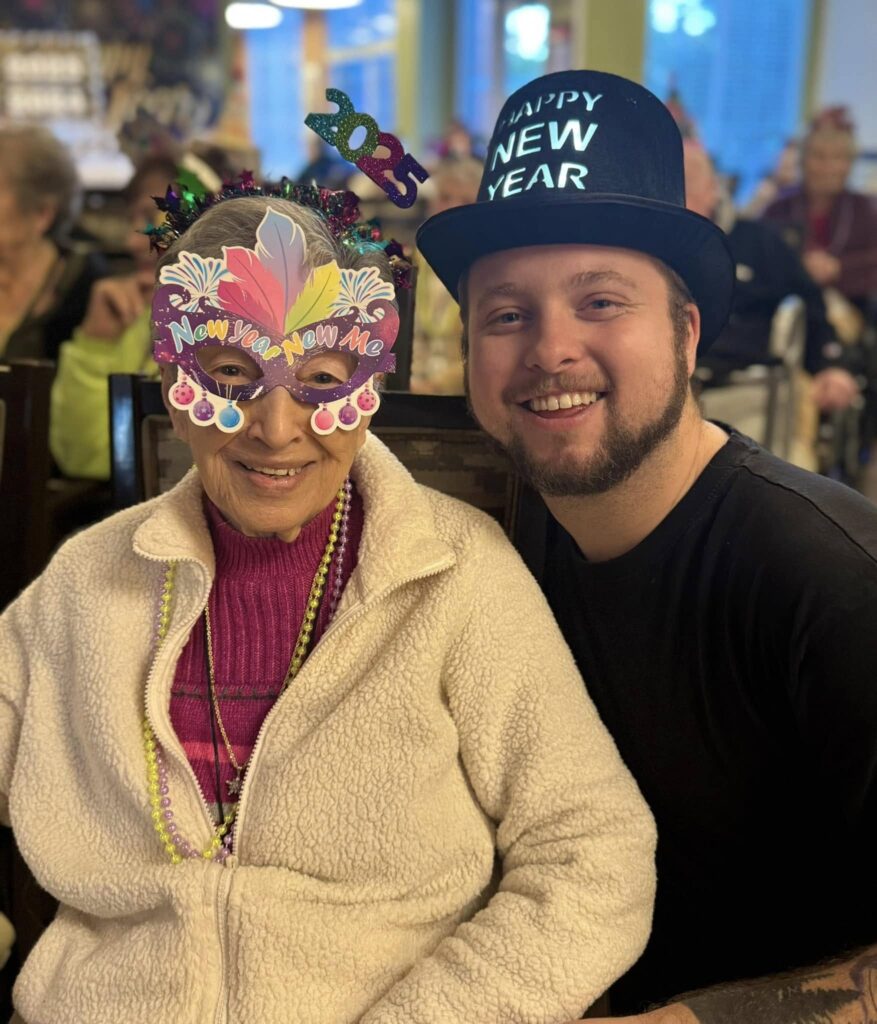Deciding the next steps in your or your loved one’s care can be one of the most challenging tasks to take on. After all, do you choose assisted living, board and care, memory care, or adult day care? And how much do memory care facilities cost anyway?
With so many questions, the task can feel somewhat daunting. Not to worry, though.
Village Walk here: our senior care specialists are here to explain the ins and outs of memory care facility costs. Whether looking at a community’s location, the type of amenities and services provided, or funding options, our team will guide you through the costs linked to memory care communities.
In this article, we’ll discuss what’s covered with memory care fees, including:
- How much, on average, memory care costs
- Considerations that will help you determine if memory care is best for you and your loved one
- Factors that affect memory care costs
- Ways to pay for memory care
- Memory care versus other types of senior living care costs
- Resources to help with the costs of memory care
- Frequently asked questions (FAQ) about memory care costs
The most and least expensive states for memory care costs
| Some of the most expensive states for memory care | Some of the most expensive states for memory care |
| 1. Hawaii 2. New York 3. New Hampshire 4. Vermont 5. Massachusetts 6. Maine 7. California | 1. South Dakota 2. Alabama 3. Mississippi 4. Utah 5. South Carolina 6. Wyoming 7. New Mexico |
On average, how much does memory care cost?

Here’s a sobering fact: on a nationwide level, aggregate care for older people with Alzheimer’s and other forms of dementia cost about $157 billion in 2023 alone (Statista, 2025). Needless to say, caring for dementia and other forms of Alzheimer’s can cost a great deal.
While Medicare and Medicaid will cover about two-thirds of these costs, the remaining costs are left to the care recipient and their families to cover.
Thus, you’ll want to know how these costs break down from month to month — and what’s covered by Medicare, Medicaid, and other forms of insurance — to determine how much you’ll pay out of pocket.
About monthly memory care costs
Speaking of memory care settings, memory care communities are located inside assisted living communities. But, assisted living costs don’t include or cover memory care expenses.
The reason is memory care staffers must undergo special dementia training to help prevent memory loss-related behaviors such as wandering. The extra staff qualifications and facility adjustments can explain away the difference in average monthly costs of memory care.
Breaking down monthly memory care costs
The monthly cost of memory care units, especially those located in assisted living communities, charge a base monthly fee for the services and amenities offered in memory care.
Some of those services and amenities include the cost of covering a shared or private room, three daily meals, planned social activities, and 24/7 emergency support.
With that being said, if you decide to add extra personal care services such as medication administration, help with activities of daily living (ADLs), bathing, dressing, and more, you may incur additional fees.
Often, the base fee cited by a memory care institution won’t include these extra fees, so you’ll want to ask the memory care community which services are covered in their general fees.
What’s more, memory care units that are located inside nursing homes also charge an all-inclusive monthly fee. The monthly fee covers planned social activities, snacks, three daily meals, medical care, and personal care (sans hospitalization) for residents.
But, this monthly fee doesn’t always include secondary memory care costs. We’ll discuss secondary memory care costs at greater length in the next section.
Secondary memory care costs (and tax deductions)
A couple of secondary memory care costs that may be tax deductible include the following fees:
- An initial community fee
- Annual memory care rate increases
Memory care communities and other senior living communities charge residents an initial fee prior to moving in. This fee may be refundable, but receiving a refund varies from community to community.
What’s more, you’ll find that in memory care communities — among other senior living communities — rates increase each year. The next time you book a tour of a memory care facility, ask a senior care specialist about their rates, by how much rates increase, and when.
In fact, long-term care services that help treat and maintain the well-being of individuals with chronic illnesses may be tax-deductible. A resident who can’t perform at least two ADLs without at least 90 days and who needs help due to cognitive impairments may be eligible to write off care services as a tax-deductible expense.
As always though, check with a tax professional or elder care specialist, as each person’s health and financial situation is different.
Considerations to determine if memory care is best

Consider this: memory care can be expensive — but it can also help provide family caregivers with respite from 24/7 caregiving for a loved one with dementia.
Before determining if memory care is right for you, you’ll want to weigh the pros and cons of assisted living communities. Understanding how assisted living and memory care work will help you determine if memory care is right.
You’ll want to keep in mind whether caring for your loved one at home is a viable solution for you and your loved one for the long-run. If symptoms progress to a point where extra help is warranted, you might want to consider assisted living options.
For example, for a person with slight physical limitations and few health care needs, staying at home might be best for them.
But, for an individual with memory impairments and who relies on multiple care professionals for their healthcare needs, memory care may be a better option for them.
As you consider which health care option is best, do your research and check all care options in your area. Doing so will give you a better understanding of which care setting and level of care is best for you and your loved one.
Key factors that affect memory care costs

As you do your research, you’ll notice four key factors that affect memory care costs:
- The geographical location of the facility
- The size of the living space
- The level of care offered at each facility
- The amenities provided
We’ll explore each in the sections below.
The location
The cost of senior living communities and residential care will differ based on where you live. Sometimes, the price can vary as much as $2,500 or more per month depending on the type of memory care facility and services provided.
As a general rule of thumb, memory care in urban areas tends to be more expensive than in rural, less populous areas. Also, where memory care is limited and demand is high, dementia care costs more.
The size of the living space
Memory care facilities offer different living arrangements. Residents can opt for a comfortable and spacious private or shared room.
The cost of care will differ depending on whether you choose a private or shared room. A 2023 Genworth.com survey shows that the median monthly cost of a shared room in an assisted living facility is about $5,350 per month.
As a comparison, the median monthly cost of a semi-private room in a nursing home is $8,669 and a private room is $9,733 a month.
In general, memory care neighborhoods price out somewhere between that of assisted living communities and nursing homes. But, note that medicaid will only cover the cost of a shared room — not a private room — in a memory care facility.
For Medicaid-eligible older adults, we recommend reaching out to a senior care specialist to determine which services, care, and amenities are covered by Medicaid.
The level of care needed
Speaking of level of care, the scope of dementia care needed can affect total costs. The level of care needed will vary based on the kind of dementia a person has and how long they’ve been living with dementia.
For example, individuals in the earlier stages of dementia may need fewer support services. As dementia progresses, care needs tend to increase and someone with dementia may need to transition to a new care program that can better care for more pronounced memory loss.
In general, the more care a resident needs (and uses), the more expensive the memory care program will be.
If you or a loved one is in the earlier stages of dementia, you can never go wrong by planning for your care needs now in preparation for the future.
The amenities
One of the other benefits of memory care is the amenities. The best memory care facilities offer on-site amenities like communal dining rooms, beauty salons, courtyard spaces, and much more.
But, do keep in mind that a memory care community with quality amenities doesn’t always mean they offer the best care. The best memory care communities offer both top-quality care and exceptional amenities.
As such, the more amenities that a memory care facility provides, the higher the monthly payment will be to live in the memory care community.
Ways to pay for memory care

We get it: the associated costs of memory care can add up fast. The cost of a facility is a large factor in deciding if memory care is the right choice for you and your loved one.
If possible, before dementia is diagnosed, we recommend being proactive. Reach out to a senior care specialist or elder law attorney to plan the next chapter of your older adult life.
With a senior care specialist and elder law attorney, you can discuss financial planning, asset management, and asset restructuring to find the most affordable and comprehensive care plans and facilities for your needs.
For example, many of our residents use the following means to pay for memory care:
- Personal care expenses like savings, Social Security benefits, 401(k) funds, pension payments, and stocks
- Long-term care insurance (note: some insurers instate an elimination period in which the insured must pay out-of-pocket for services; in other words, policies don’t always cover the full cost of care)
- Veterans Aid (VA) benefits
- Life insurance
- Home equity
- Medicare
- Medicaid
Memory care vs. other senior living care costs

So far, we’ve talked a great deal about memory care.
“But what about other senior living care options?” You might wonder. How does memory care stack up to other forms of independent living?
Memory care tends to be more expensive than independent living or assisted living communities, but less expensive than nursing home care. What’s more, full-time in-home care can be more affordable than care in a memory care community.
Especially with in-home care, you’ll want to factor into account the cost of a mortgage and other significant expenses when evaluating the cost of care plans.
As you weigh your options, you might also want to think about the fact that someone living with dementia who uses a home health aide may not need full-time help. Consider the number of hours you and your loved one plan to use when caring for yourself or an older adult.
Finally, you can also consider using adult day services. Adult day services are located in community-based centers.
Open on weekdays, community-based centers provide older adults living with dementia with personal care services and engaging activities. Adult day services can help caregivers who work full-time or who need a break from caregiving once in a while.
With that being said, these facilities don’t provide the quality of life that a memory care community can. As such, adult day services aren’t suitable for people living with severe memory loss.
Resources to help you with memory care costs

Though financial resources vary from state to state, we’ve found that many free and low-cost resources are available to dementia caregivers and individuals living with dementia.
Many local and national support groups exist in which dementia caregivers can speak with other caregivers about their experience working with memory care costs. Alternatively, many assisted living and memory care facilities house a library of well-researched content available to the public at any time for your reading pleasure.
Also, feel free to make use of all the complimentary resources available online.
Did you know?
Did you know that memory issues creep up little by little over time? Seniors can go years without noticing any significant difference in their memory by relying solely on the help of family or friends.
To read more information about memory care and how to know when you or a loved one may need further assistance or support, check out our publication all about assisted living versus memory care.
Receive free senior care advice on memory care costs

In summary, the cost of memory care will depend on factors such as the location, living arrangement, level of care needed, and amenities that the facility offers.
Since the median cost of a room in an assisted living facility in the U.S. was $5,350 as of 2023, in general, you can expect to pay north of this number for memory care.
You can always pay for memory care using personal savings, long-term care insurance, veterans benefits, stocks, Medicaid, Medicare, and pensions.
We understand that understanding the specific costs of memory care can be challenging and confusing. If you think memory care might be the right choice for you or a loved one, we recommend reaching out to as many people as possible to decide if memory care is right.
Friends, family members, elder law specialists, health care providers, and senior care concierge staff can help give you new perspectives on how to help pay for memory care.
If you’d like, you’re also always invited and welcome to give our memory care specialists a call anytime. We’re happy to help and are all ears.
To learn more about how to help pay for memory care, don’t hesitate to contact us.
Frequently asked questions (FAQ) about memory care costs

1. What’s the largest difference between assisted living and memory care facility costs?
Since assisted living is for older adults who need daily care but not skilled nursing, assisted living tends to cost less than memory care. Memory care is for individuals living with Alzheimer’s and other forms of dementia.
People living with memory loss need more care than those in assisted living facilities. The great news is that most assisted living communities are built to house memory care residents.
Separate memory units exist within the assisted living facility, thereby allowing residents to receive the care they need in one single location.
2. Is the cost of a memory care facility negotiable?
In certain areas, yes. Many memory care communities are willing to work with you if the cost is just a smidge out of your budget.
What’s more, some communities offer move-in incentives and discounts at certain times of the year.
3. How can I lower the cost of memory care for my loved one?
Working with a geriatric care manager can help you find the most affordable memory care options for your and your loved one’s needs. Also, many senior care specialists can help you find grants and other resources that help offset select memory care costs.








